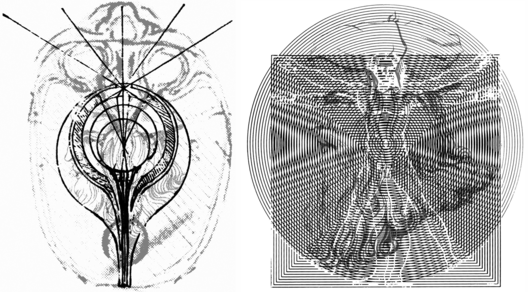Leonardo da Vinci1452–1519
Dissection of human bodies has always been a fraught area of enquiry, and relatively little progress had been made since the time of Galen in the second century to that of Leonardo. Galen was one of the greatest of the Greek anatomists who based his anatomy on dissections of animals, particularly monkeys. He drew extensively on the anatomical writing of Herophilus (ca. 335-425 B.C.), which are now lost, and on the physiological speculations of Erasistratus (ca. 310-250 B.C.), both of whom based them on dissections of human and animal bodies. In the fourteenth century, sanctions prohibiting dissection of human bodies were relaxed. This happened initially for medico-legal purposes but eventually spread to the field of anatomical investigation. As a consequence of this, knowledge concerning anatomy in general and the brain in particular slowly began to be based on more secure grounds, although the descriptions were not always accurate and observation often remained a slave to Galenic dogma. The dissecting skills of the anatomist were critical, and the major advances came with practitioners like Leonardo da Vinci, Eustachi and Vesalius.
Vasari, in his Lives of the Artists wrote that the anatomist, Marc’ Antonio della Torre (1481-1511) “was wonderfully aided by the genius and labour of Leonardo, who filled a book with red crayons, outlined with the pen, all copies made with the utmost care (from bodies) dissected by his own hand”. Leonardo’s detailed drawings of dissections did not make much immediate impact because they remained both in manuscript form and in private hands. Unlike his anatomical drawings of the musculature, those of the eye and brain reflected a conflation of dissection and dogma: his rather crude drawings reflected a reliance on Galen, even though he did prepare the excised eye (by boiling it in the white of an egg) for dissection. His drawings of the eye showed the lens as spherical and central in the eye, and the optic nerves passed to the cerebral ventricles. Three ventricles were enumerated in Galenic anatomy, and Albertus Magnus (ca. 1198-1280) and other medieval scholars incorporated them into philosophy as representing the sites of perception, reasoning, and memory. Leonardo was adhering to the ancient “three-cells” ventricular theory – as is evident in the portrait on the left: Leonardo’s diagram of the visual pathways shows the optic nerves leading directly into the first of the three ventricles without even meeting at the optic chiasm. He also likened the eye to a camera, but he made structure subservient to function. Because he considered that vision took place in the eye, and our visual experience is of an upright world, he indicated that there are two inversions and reversals in the eye so that the image is upright. Nonetheless, Leonardo did base his anatomy on observation, both of the whole body and its parts. With regard to the proportions of the whole body, he used the ideas of the Roman architect Marcus Vitruvius Pollio (ca. 88-26 B.C.), more commonly known simply as Vitruvius. He added an aesthetic dimension to architecture through the harmony of circle and square, and both shapes were in turn related to the symmetry of natural objects like the human body. When the arms are extended horizontally and legs together the extremities of the square are touched, but with raised arms and parted legs they are in contact with the circumference of a circle centred on the umbilicus: “Now the navel is naturally the exact centre of the body. For if a man lies on his back with hands and feet outspread, and the centre of a circle is placed on his navel, his figure and toes will be touched by the circumference. Also a square will be found described within the figure, in the same way as a round figure is produced. For if we measure from the sole of the foot to the top of the head, and apply the measure to the outstretched hands, the breadth will be found equal to the height, just like sites which are squared by rule”. Leonardo da Vinci represented these relationships in a drawing that has become known as ‘Vitruvian man’, and it is visible in the figure on the right, which also contains Leonardo’s portrait. The background reflects the moiré patterns derived from the interplay between concentric circles and squares.
